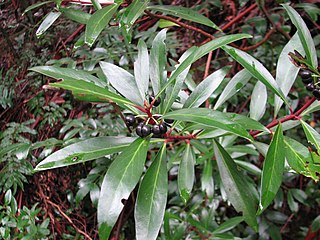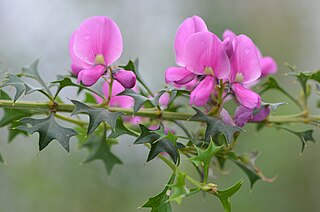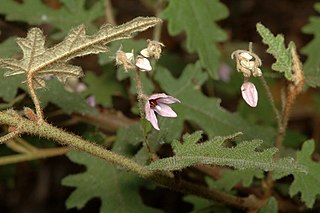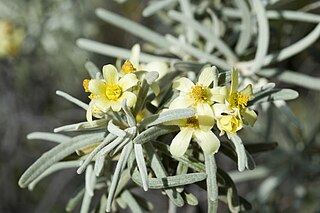
Tasmannia is a genus of about 36 species of flowering plants in the family Winteraceae, and is native to Australia and New Guinea, with one species also found in parts of Southeast Asia. Plants in the genus Tasmannia are shrubs or small trees, usually dioecious with simple leaves, mostly white, sometimes yellow flowers, and one to many clusters of berries.

Tasmannia stipitata, commonly known as the Dorrigo pepper or northern pepperbush is a rainforest shrub of temperate forests of the Northern Tablelands of New South Wales, Australia. Leaves are fragrant, narrow-lanceolate to narrow-elliptic, 8–13 cm long. Dark bluish to mauve berries follow the flowers on female shrubs. The species is dioecious, with male and female flowers on separate plants.

Murraya paniculata, commonly known as orange jasmine, orange jessamine, china box or mock orange, is a species of shrub or small tree in the family Rutaceae and is native to South Asia, Southeast Asia and Australia. It has smooth bark, pinnate leaves with up to seven egg-shaped to elliptical leaflets, fragrant white or cream-coloured flowers and oval, orange-red berries containing hairy seeds.

Eremophila lactea, commonly known as milky emu bush, is a flowering plant in the figwort family, Scrophulariaceae and is endemic to Western Australia. It is an erect shrub with its branches and leaves mostly glabrous but with white blotches due to the presence of dry resin. It is a critically endangered plant species mostly found in disturbed areas such as roadsides.

Tasmannia purpurascens, commonly known as the broad-leaved pepperbush or purple pepperbush is a shrub in the primitive family Winteraceae and is only found growing in the Barrington Tops and Ben Halls Gap regions of New South Wales. It is locally abundant in a restricted subalpine habitat with a high rainfall, often growing in the ecotone in association with Antarctic Beech.

Prostanthera eurybioides, commonly known as Monarto mintbush, is a species of flowering plant in the family Lamiaceae and is endemic to the south-east of South Australia. It is a low, spreading shrub with densely hairy branches, thick, elliptic to egg-shaped leaves clustered on short shoots, and violet to mid-purple flowers that are white with orange and dark purple dots inside the petal tube.

Seringia nephrosperma, commonly known as free-carpel fire-bush, is a species of flowering plant in the mallow family and is endemic to northern Australia. It is an upright, suckering shrub with hairy new growth, usually oblong to lance-shaped leaves, and purple flowers arranged in groups of 5 to 25.

Seringia hermanniifolia, commonly known as crinkle-leaved firebush, is a species of flowering plant in the mallow family and is endemic to the south-west of Western Australia. It is a low-growing or prostrate, suckering shrub with hairy new growth, hairy, wavy, oblong to egg-shaped leaves and mauve to bluish flowers arranged in groups of 3 to 8.

Seringia velutina, commonly known as velvet firebush, is a species of flowering plant in the family Malvaceae family and is endemic to the south-west of Western Australia. It is a suckering shrub that sometimes forms dense colonies. Its leaves are narrowly elliptic to egg-shaped and it has 3 to 11 pale pink to purple flowers arranged in loose cymes.

Mirbelia dilatata, commonly known as holly-leaved mirbelia, is a species of flowering plant in the family Fabaceae and is endemic to the south-west of Western Australia. It is an erect, bushy, shrub with prickly leaves and pink, purple or violet flowers.

Pomaderris cocoparrana, commonly known as Cocoparra pomaderris, is a species of flowering plant in the family Rhamnaceae and is endemic to a restricted area of New South Wales. It is a shrub with hairy stems, egg-shaped to more or less round leaves, and clusters of yellow flowers.

Lasiopetalum pterocarpum, commonly known as wing-fruited lasiopetalum, is a species of flowering plant in the family Malvaceae and is endemic to a restricted area in the south-west of Western Australia. It is an open shrub with many densely hairy stems, egg-shaped and lobed leaves and pink and dark red flowers.
Senna glaucifolia is a species of flowering plant in the family Fabaceae and is endemic to arid Central Australia. It is an erect shrub with pinnate leaves with two to four pairs of elliptic leaflets, and yellow flowers arranged in groups of four to seven, with ten fertile stamens in each flower.
Ricinocarpos brevis is a species of flowering plant in the family Euphorbiaceae and is endemic to inland Western Australia. It is a monoecious, densely-branched shrub with narrowly oblong leaves and male and female flowers arranged singly or in small groups.

Ricinocarpos velutinus is a species of flowering plant in the family Euphorbiaceae and is endemic to the south-west of Western Australia. It is an erect, rounded, usually monoecious shrub with linear leaves, and yellow flowers with either all female or all male flowers, or one or two female flowers with up to 13 male flowers below them.
Seringia adenogyna, commonly known as skinny-leaved fire-bush, is a species of flowering plant in the family Malvaceae and is endemic to the south-west of Western Australia. It is an erect shrub with hairy new growth, linear to narrowly oblong leaves and purple flowers usually in groups of 2 to 4.
Seringia × katatona, commonly known as red dune fire-bush, is a species of flowering plant in the mallow family and is endemic to northern Western Australia. It is an erect, compact, suckering shrub, with hairy young branches, egg-shaped to elliptic leaves and purple flowers arranged in groups of 9 to 17.
Seringia saxatilis, commonly known as gorge fire-bush, is a species of flowering plant in the mallow family and is endemic to Kalbarri National Park in Western Australia. It is a sprawling, open shrub with hairy young stems, oblong to broadly elliptic leaves and purple flowers arranged in groups of 3 to 6.
Seringia undulata, commonly known as wavy-leaf fire-bush, is a species of flowering plant in the mallow family and is endemic to a small area of inland Western Australia. It is a suckering, upright shrub with hairy, rust-coloured young stems, oblong, wavy leaves and purple flowers arranged in groups of 6 to 8.

Wilkiea angustifolia is a species of flowering plant in the family Monimiaceae, and is endemic to Queensland. It is a dioecious shrub with elliptic leaves, male and female flowers on separate plants, male flowers with 4 stamens, female flowers with 8 to 20 carpels, and the fruit a purple to black drupe.

















